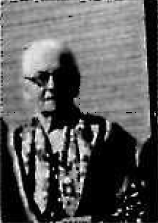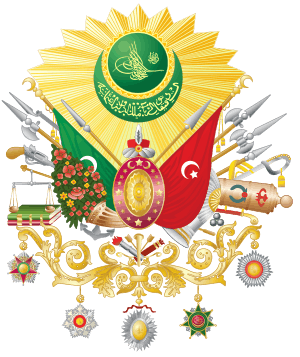Sazkar Hanım
Sazkar Hanım (Ottoman Turkish: سازکار خانم; born Zekiye Maan; 8 May 1873 – c. 1945) was the ninth wife of Sultan Abdul Hamid II of the Ottoman Empire.[1]
| Sazkar Hanım | |||||
|---|---|---|---|---|---|
 | |||||
| Born | Zekiye Maan 8 May 1873 Kayalar, Adapazarı, Istanbul, Ottoman Empire | ||||
| Died | c. 1945 (aged 71–72) Beirut, Lebanon | ||||
| Burial | |||||
| Spouse | |||||
| Issue | Refia Sultan | ||||
| |||||
| House | Maan (by birth) Ottoman (by marriage) | ||||
| Father | Recep Bata Maan | ||||
| Mother | Rukiye Havva Hanım | ||||
| Religion | Sunni Islam | ||||
Early life
Sazkar Hanım was born on 8 May 1873 in Kayalar, Adapazarı, Istanbul. Born as Zekiye Maan, she was a member of Abkhazian noble family, Maan. Her father was Recep Bata Bey Maan,[2][3] the son of Osman Bey Maan, and grandson of Kats Bey Maan. Her mother was Rukiye Havva Hanım Mikanba, an Abkhazian.[4] She was the first cousin of Behice Hanım, twelfth wife of Sultan Abdul Hamid II.[2][3]
She was presented in the imperial harem by Çorlulizade Mahmud Celaleddin Pasha's Abkhazian wife, Bidar Hanım.[3]
Marriage
Sazkar Hanım married Abdul Hamid on 31 August 1890 in the Yıldız Palace.[2] She was given the title of "Third Fortunate". On 15 June 1891, a year after the marriage, she gave birth to her only child, a daughter, Refia Sultan.[5]
On 27 April 1909, Abdul Hamid was deposed, and sent into exile in Thessaloniki.[6] Sazkar was closed to Abdul Hamid, and accompanied him for some time,[7] and returned to Istanbul in 1910.[1][8]
Here she first settled with her daughter,[2] and later with Peyveste Hanım, another of Abdul Hamid's wives, at her mansion in Şişli. Sazkar and Peyveste's rooms were located on the same floor. Their daily routine was to drink coffee with each other, and to talk about old times.[9]
After Thessaloniki fell to Greece in 1912, Abdul Hamid also returned to Istanbul, and settled in the Beylerbeyi Palace, where he died in 1918.[10]
Widowhood and death
As a widow, Sazkar Hanım's stipend consisted of 5,000 aspers. In 1920, her stipend was increased to 10,000. However, in 1923, she was completely deprived of her it.[2]
In 1924, the imperial family was sent into exile. Sazkar went to Beirut, Lebanon with her daughter, where she died in 1945, outliving her daughter by seven years. She was buried in Sultan Selim Mosque, Damascus, Syria.[2][11]
Issue
Sazkar Hanım and Abdul Hamid had one daughter:
- Refia Sultan (Istanbul, Yıldız Palace, 15 June 1891 – Beirut, Lebanon, 1938, buried in Sultan Selim Mosque, Damascus, Syria), married and had issue.
References
- Uluçay 2011, p. 250.
- Açba 2007, p. 142.
- Ekinci, Ekrem Buğra (March 31, 2017). Sultan Abdülhamid’in Son Zevcesi. Timaş Tarih. pp. 23, 181. ISBN 978-6-050-82503-9.
- "Marshan Family Web Site". Retrieved 25 December 2018.
- Brookes 2010, p. 288.
- Hall, Richard C. (October 9, 2014). War in the Balkans: An Encyclopedic History from the Fall of the Ottoman Empire to the Breakup of Yugoslavia. ABC-CLIO. pp. 1–2. ISBN 978-1-610-69031-7.
- Brookes 2010, p. 281.
- Sakaoğlu 2008, p. 683.
- Açba 2007, p. 145.
- Parry, Milman; Lord, Albert B. (1979). Serbocroation heroic songs, Volume 1. Harvard University Press. p. 371.
- Sakaoğlu 2008, p. 683-4.
Sources
- Açba, Harun (2007). Kadın efendiler: 1839–1924. Profil. ISBN 978-975-996-109-1.
- Uluçay, M. Çağatay (2011). Padişahların kadınları ve kızları. Ötüken. ISBN 978-975-437-840-5.
- Sakaoğlu, Necdet (2008). Bu Mülkün Kadın Sultanları: Vâlide Sultanlar, Hâtunlar, Hasekiler, Kandınefendiler, Sultanefendiler. Oğlak Yayıncılık. ISBN 978-6-051-71079-2.
_p259_Sultan_Abdul_Hamid_II.jpg)
